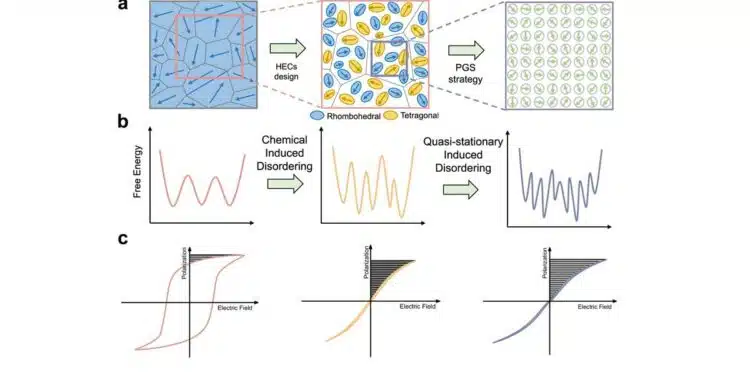Researchers from Dianzi University, Hangzhou, Zhejiang, China published their study in nature communications journal on novel polar glass state strategy to enhance energy storage performance of MLCC ceramic capacitors.
Introduction
Multilayer ceramic capacitors (MLCCs) are key components in modern electronics, prized for their compact size, high power density, and fast charge–discharge rates.
Despite significant progress, achieving both high recoverable energy density and efficiency across a wide temperature range remains challenging. This study introduces a novel “polar glass state” (PGS) strategy to overcome these limitations in Bi₀.₅Na₀.₅TiO₃-based MLCCs, enabling ultrahigh energy storage performance with exceptional thermal and cycling stability.
Key Points
- A polar glass state (PGS) strategy disrupts nanoscale ferroelectric order and minimizes hysteresis loss.
- Bi₀.₅Na₀.₅TiO₃–based MLCCs reach 22.92 J cm⁻³ recoverable energy density and 97.1% efficiency at 1200 kV cm⁻¹.
- High breakdown strength (1200 kV cm⁻¹) is achieved via hierarchical grain refinement.
- Stable performance up to 150 °C with less than 2% efficiency fluctuation.
- Excellent cycling reliability demonstrated over 10⁵ charge–discharge cycles.
Extended Summary
The escalating demand for efficient and miniaturized energy storage devices, driven by electric vehicles and pulsed power systems, calls for dielectric capacitors that deliver both high energy density and efficiency. Traditional MLCCs often suffer from significant hysteresis losses and decline in performance at elevated temperatures, limiting their broader application.
To address these challenges, the authors propose the polar glass state, a non-equilibrium structural design that “freezes” the material in a state where atomic-scale polarizations are randomly distributed. By introducing controlled chemical heterogeneity and carefully tuning sintering dynamics, long-range ferroelectric regions are disrupted, reducing remnant polarization and lowering energy barriers for polarization switching.
Using a base matrix of 0.82Bi₀.₅Na₀.₅TiO₃–0.18Bi₀.₅K₀.₅TiO₃ modified with Sr(Sc₀.₅Ta₀.₅)O₃, the team fabricated tape-cast multilayer capacitors (1.88 R-MLCCs) with six dielectric layers and platinum electrodes. These capacitors exhibit ultralow hysteresis loops at room temperature, with a maximum polarization (Pₘ) of 58.5 μC cm⁻² and a remnant polarization (Pᵣ) near zero.
Energy storage testing under a field of 1200 kV cm⁻¹ reveals a recoverable energy density of 22.92 J cm⁻³ and efficiency of 97.1%. Weibull analysis shows an increase in breakdown strength from 425 kV cm⁻¹ in bulk ceramics to 1200 kV cm⁻¹ in MLCCs, thanks to grain size reduction to roughly 0.5 μm. Performance remains robust up to 150 °C, delivering over 14 J cm⁻³ with under 2% efficiency drop.
Reliability tests highlight impressive cycling stability, with less than 1% degradation after 10⁵ cycles at 800 kV cm⁻¹. Fast discharge experiments demonstrate over 16 J cm⁻³ released within 2.8 μs, confirming suitability for high-power pulsed applications.
Comprehensive structural analyses across multiple scales—atomistic via AC-STEM, short-range by total scattering, long-range by XRD, and micro-range by PFM—validate the persistence of the PGS from 25 °C to 150 °C. The randomized polarization distribution and stable R/T phase coexistence underpin both the high energy storage capabilities and thermal resilience.
Conclusion
This work establishes the polar glass state as a transformative design paradigm for MLCCs, achieving record-high energy density and efficiency alongside unmatched thermal and cycling reliability. By engineering disorder at multiple length scales, the study paves the way for next-generation dielectric capacitors in demanding applications, from compact on-chip energy storage to advanced pulsed power systems.
Read the full original scientific paper here:
Zhao, W., Liu, Z., Xu, D. et al. Advanced stability and energy storage capacity in hierarchically engineered Bi0.5Na0.5TiO3-based multilayer capacitors. Nat Commun 16, 6549 (2025). https://doi.org/10.1038/s41467-025-61936-2































